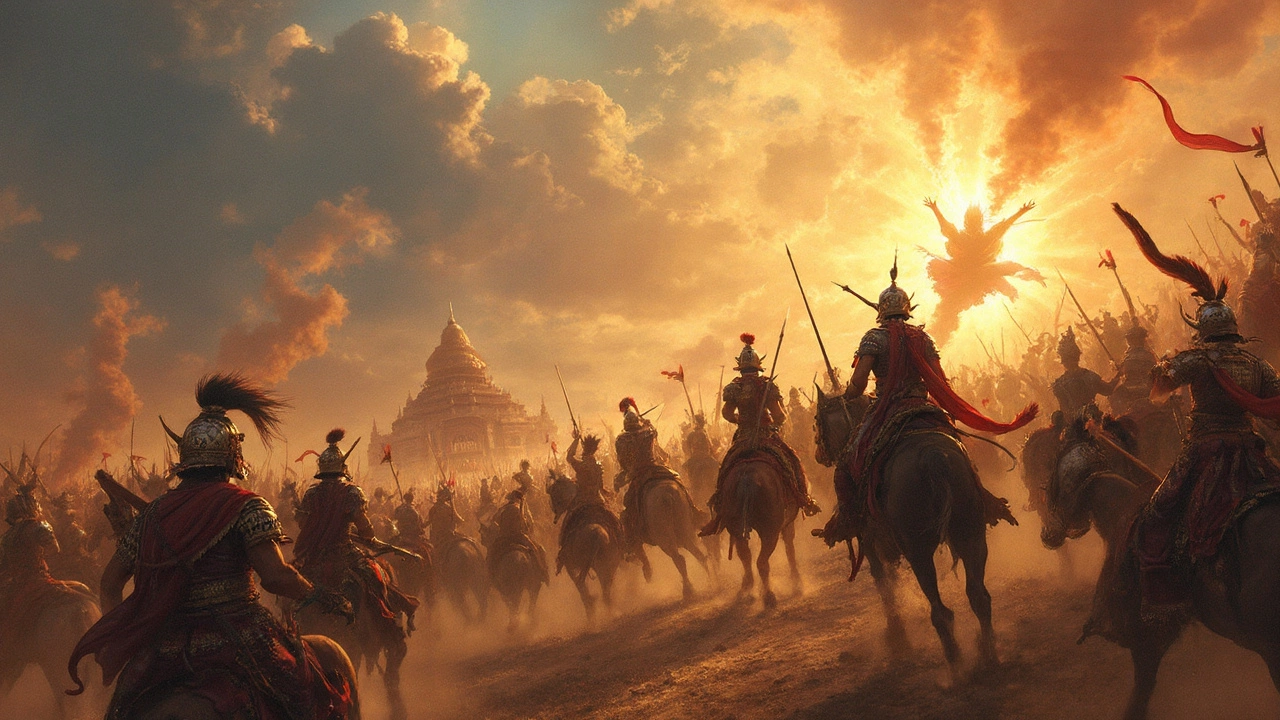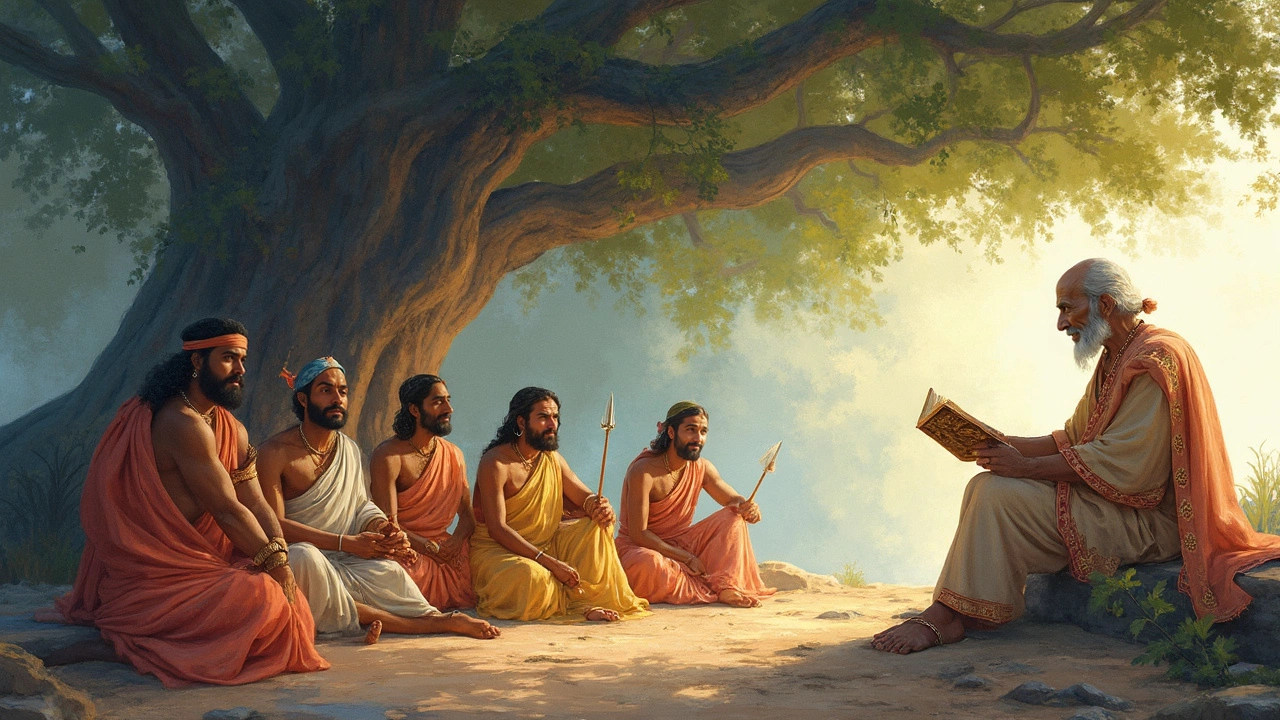Is Mahabharat Real or a Myth?
 Apr, 3 2025
Apr, 3 2025
Alright, have you ever wondered if the Mahabharat is more than just a really long story from ancient times? It's like this larger-than-life epic packed with drama, wars, and life lessons. Seriously, think of it as a blockbuster that people have been talking about for ages.
But here's the real question: Did it actually happen, or is it just myth? Some folks swear it’s real, thanks to intriguing archaeological finds and ancient texts. Others see it as symbolic, a kind of grand narrative that teaches us about life, ethics, and everything in between.
Either way, it's fascinating how something so old still pops up in our conversations and even impacts the way some people think and live today. Whether you're a history buff or just someone who loves a good story, there's a lot to uncover about this epic. So, let's break it down, shall we?
- The Epic in a Nutshell
- Historical Evidence
- Cultural Significance
- Lessons from the Mahabharat
- Why It Matters Today
The Epic in a Nutshell
So, what is this Mahabharat that everyone in India seems to know? Imagine a saga that’s longer than anything you’d binge on Netflix—it's got about 100,000 verses, making it one of the longest epics in the world. It’s not just a story; it’s like a whole universe of characters, emotions, and lessons.
The Mahabharat offers a snapshot of life in ancient India, detailing two warring families, the Pandavas and the Kauravas. It all boils down to a big fight for power and an epic battle that’s known as the Kurukshetra War. Kinda like a Shakespearean play but on steroids.
The main heroes are the Pandavas, five brothers each representing different virtues. They’re led by Yudhishthira, known for his righteousness. On the other side, there’s the ambitious Duryodhana and his 99 brothers, the Kauravas. All of this is set against a backdrop of complex human emotions, divine interventions, and moral dilemmas.
One of the epic’s key highlights is the Bhagavad Gita, a conversation between Prince Arjuna and Lord Krishna, who serves as his charioteer. It delves deep into life’s philosophies and duty, which is a big deal even today.
And it’s not just about battles and philosophy. There are magical weapons, spells, and even time travel to some extent. Plus, who can forget Draupadi, whose humiliation in the court becomes one of the triggers for the epic war?
For those wondering about the nitty-gritty, scholars believe it was written over several centuries, somewhere around 400 BCE to 400 CE. Veda Vyasa is credited as the author, though it’s likely a culmination of stories passed down orally over generations.
Historical Evidence
So, you're curious about whether the Mahabharat is a real thing that happened or just a legendary tale? You're not alone! It's a debate that's been sparking curiosity for a long time, and there's some pretty interesting stuff to chew over.
Let's talk archaeology first. In places like Kurukshetra, which is said to be the battlefield of the Mahabharat, some folks claim they've found artifacts that could link back to the time of the epic. Pottery shards, weaponry fragments, and even ancient fortifications make people wonder if these are remnants of the big war described in the epic.
On top of that, some ancient Indian texts outside of the Mahabharat itself mention characters and events from the epic, kind of like ancient cross-references. This doesn't exactly scream proof but adds a touch of intrigue.
There are also efforts to match astronomical descriptions from the epic to known events in history. Some have claimed that eclipses and alignments noted in the Mahabharat could match specific dates thousands of years ago. This is where things get both exciting and complicated because, let's be real, the stars are a bit tricky to pin down!
Of course, not everyone is convinced. Some scholars think these links are more coincidental or maybe just myth dressed up in history's clothing. And that's fair – legends often pull from reality a bit to craft their magic.
In the end, whether these bits of evidence make the Mahabharat a historical fact or a really detailed myth is still up in the air. But it sure does make for some interesting dinner table chat, doesn't it?

Cultural Significance
Ever thought about how the Mahabharat is more than just an epic story? It's like a cultural powerhouse in India. Seriously, it's been shaping the way folks think and behave for centuries.
First off, let's talk about religion. The Mahabharat isn't just a tale; it's sacred text for many Hindus. You've got characters like Krishna who play divine roles, offering guidance and wisdom. It's not uncommon to see teachings from the Mahabharat creeping into everyday life choices, rituals, and even festivals.
Then there's the art and literature. This epic is like a never-ending source of inspiration. Whether it's for paintings, dance forms, or even Bollywood movies, artists find a goldmine of ideas in those pages. The character arcs, heroic battles, and moral dilemmas offer endless storytelling possibilities.
And hey, don't underestimate its impact on values and ethics. Lessons from the Mahabharat about loyalty, duty, and righteousness are often discussed across generations. It's like having a family chat where grandparents drop some timeless wisdom thanks to these stories.
Pretty cool, right? It goes way beyond being just a bedtime story and seeps into the very fabric of cultural identity. So, next time you hear someone mention it, you'll know it's not just about gods and warriors but about a whole cultural vibe that’s influenced lifestyles and beliefs across centuries.
Lessons from the Mahabharat
The Mahabharat isn't just an old tale; it's like a life manual wrapped in epic battles and family drama. It’s packed with lessons that resonate even today. One big takeaway is the idea of duty or 'dharma'. Characters like Arjuna and Bhishma face tough choices about what's right and wrong, showing us how complicated doing the 'right thing' can be.
Then there's the famous Bhagavad Gita, a part of this epic where Krishna gives Arjuna a serious pep talk. Here, the focus is on selflessness and understanding your role in the bigger picture. It's like having a personal mentor reminding you that actions can have a ripple effect and sometimes personal desires take a back seat to greater good.
The importance of integrity is another strong lesson. Look at how Yudhishthira is often praised for his honesty. His commitment to truthfulness teaches us that trust and integrity can bring peace, even if the path is rocky.
Plus, the Mahabharat doesn't shy away from showing the destructive power of pride and greed. Duryodhana's story is a clear warning about where unchecked ambition and jealousy can lead. It's kind of like a cautionary tale for anyone getting too caught up in their ego or possessions.
In short, whether you're dealing with personal dilemmas or finding your place in the world, there are nuggets of wisdom in this epic. It's no wonder it still strikes a chord with so many people, regardless of the debate whether it’s myth or reality.

Why It Matters Today
Alright, so why does the Mahabharat still hold a place in our modern world? It might feel like an ancient story, but trust me, its impact is far from old news. This epic isn't just a dusty tale of yore; it's woven deeply into India's cultural fabric and even extends beyond its borders.
First off, the Mahabharat is used as a reference in not just literature, but in art, theater, and even management studies! It's crazy how management books reference the strategies and politics from its stories. Talk about timeless lessons! For instance, concepts like dharma (duty/ethics) still resonate in decision-making processes today.
Plus, the epic’s characters symbolize different ideals: think of Arjuna's struggle with duty and morality, or Krishna’s teachings, guiding people through existential dilemmas. These narratives help folks navigate modern life, especially in how we tackle our own challenges and ethical choices.
And let’s not forget about its influence on contemporary media. Pop culture, movies, and TV series regularly find inspiration in the Mahabharat. This, in turn, keeps the stories alive for each new generation, ensuring the epic remains a captivating part of global storytelling.
If we look at some high-impact works that draw from the Mahabharat, they highlight how the themes still ring true. Whether it's about standing up for justice like Yudhishthira or facing fears like Arjuna, these lessons are woven into everyday life, reminding us that some stories are just too important to forget.